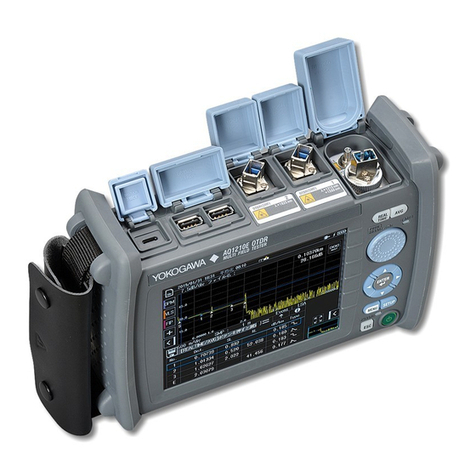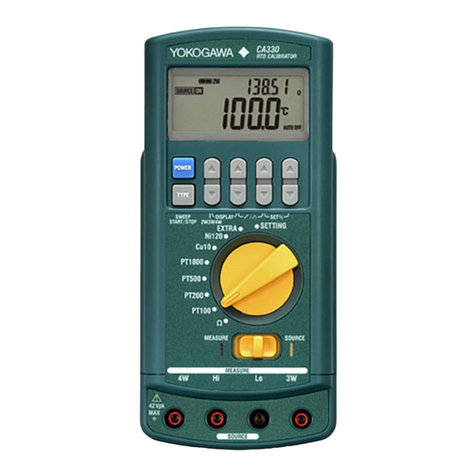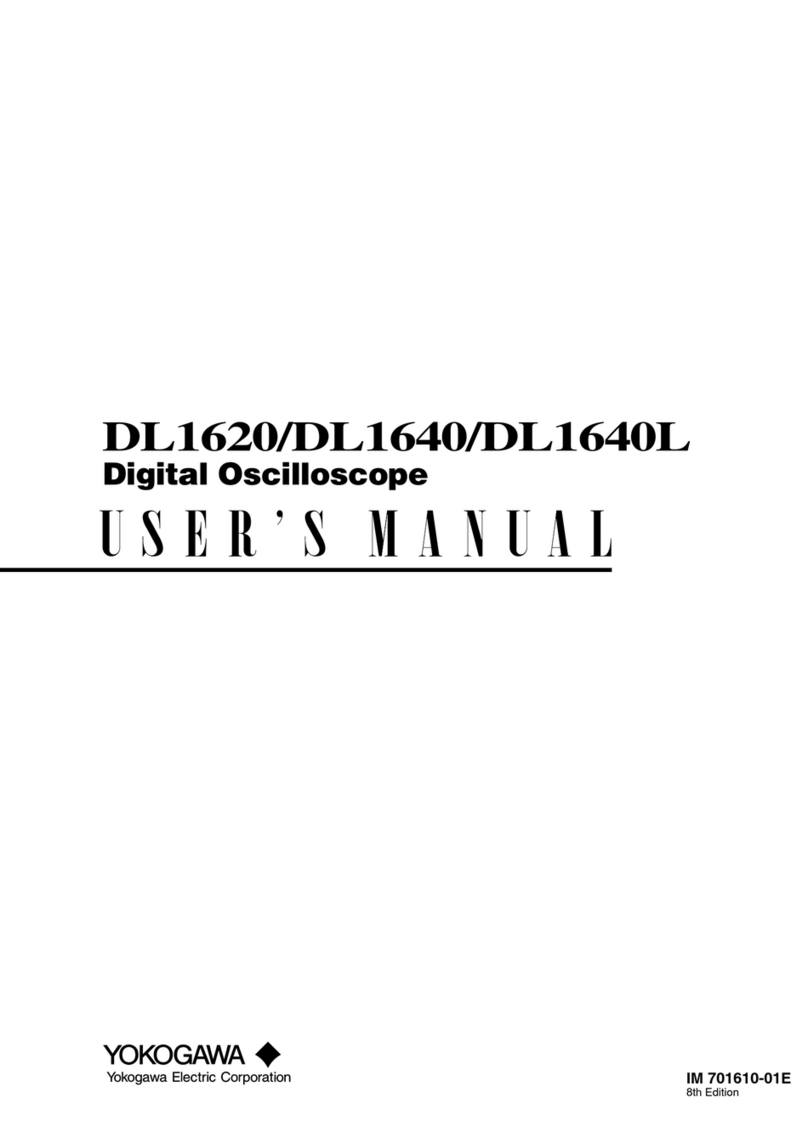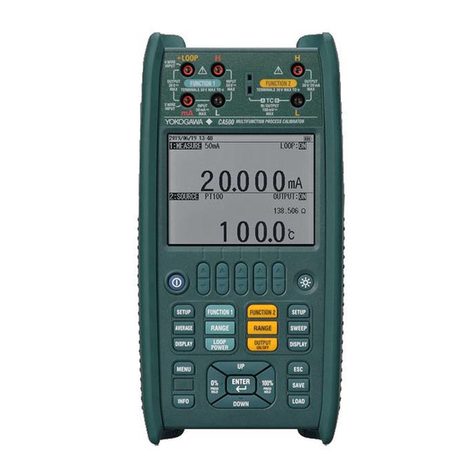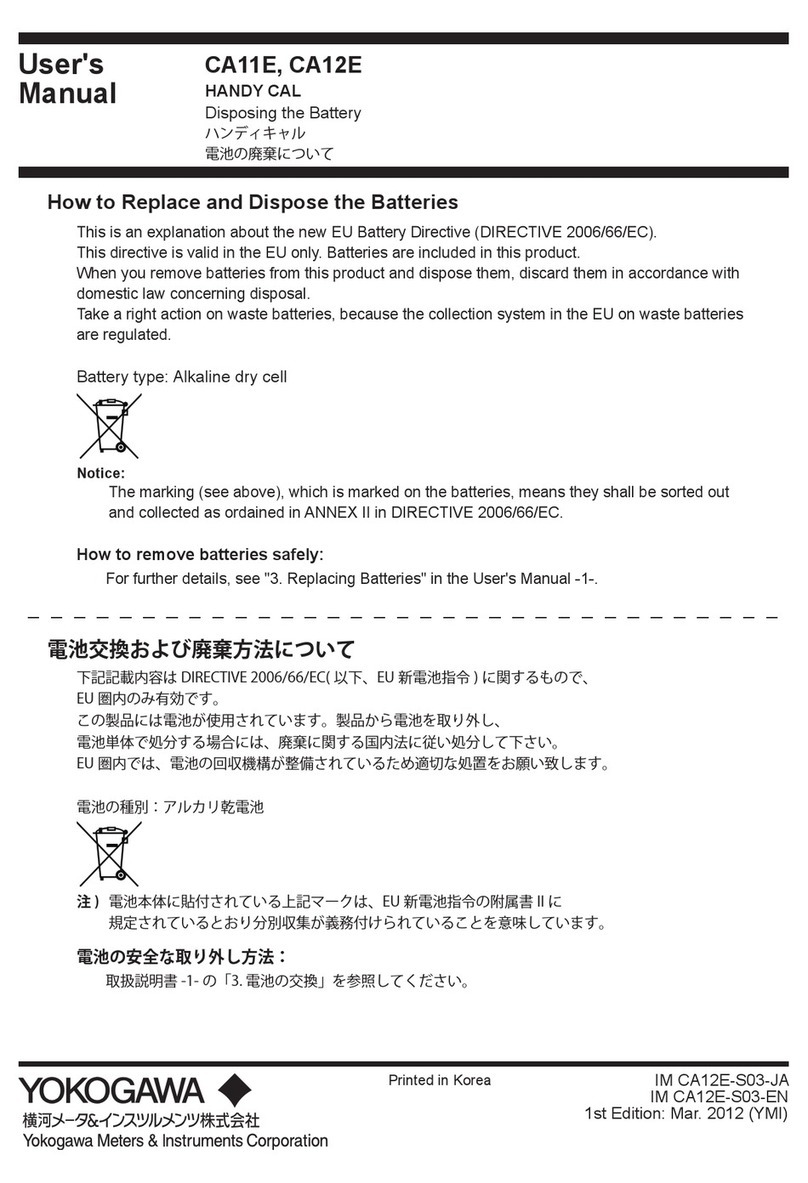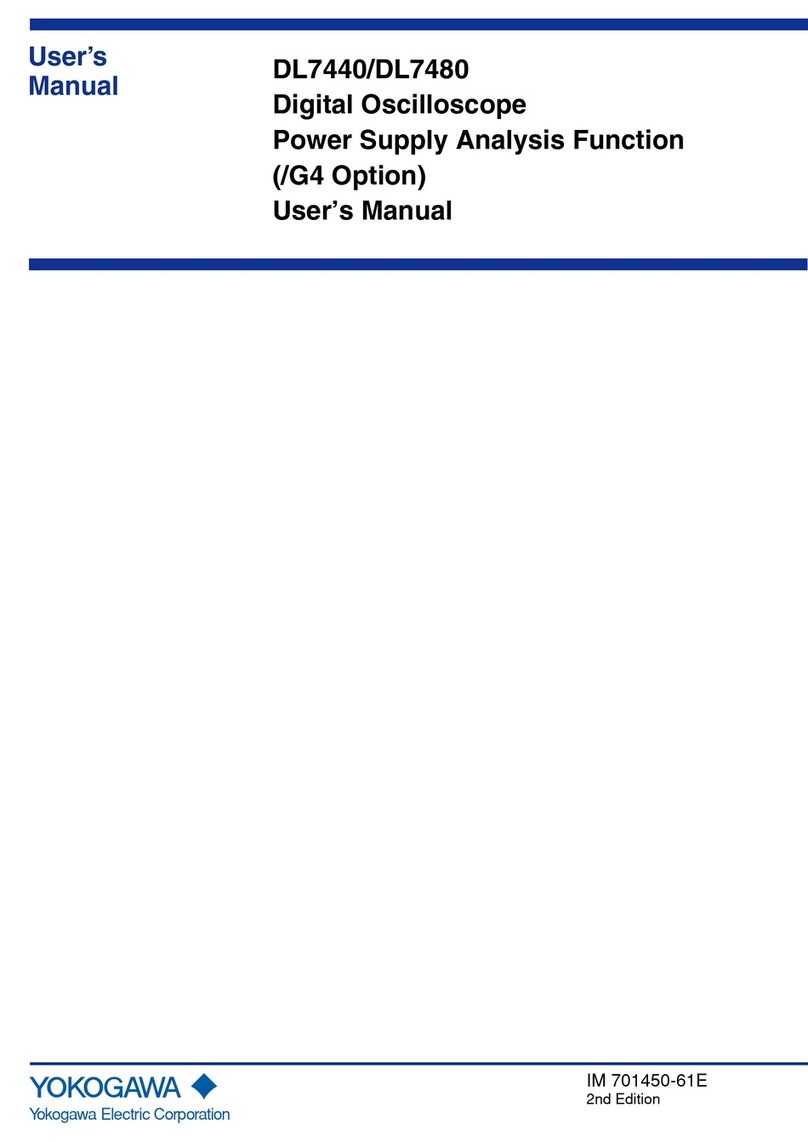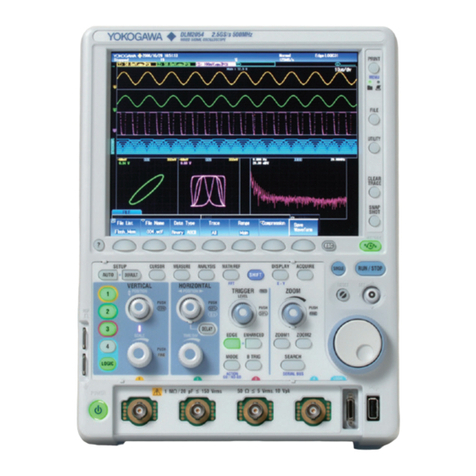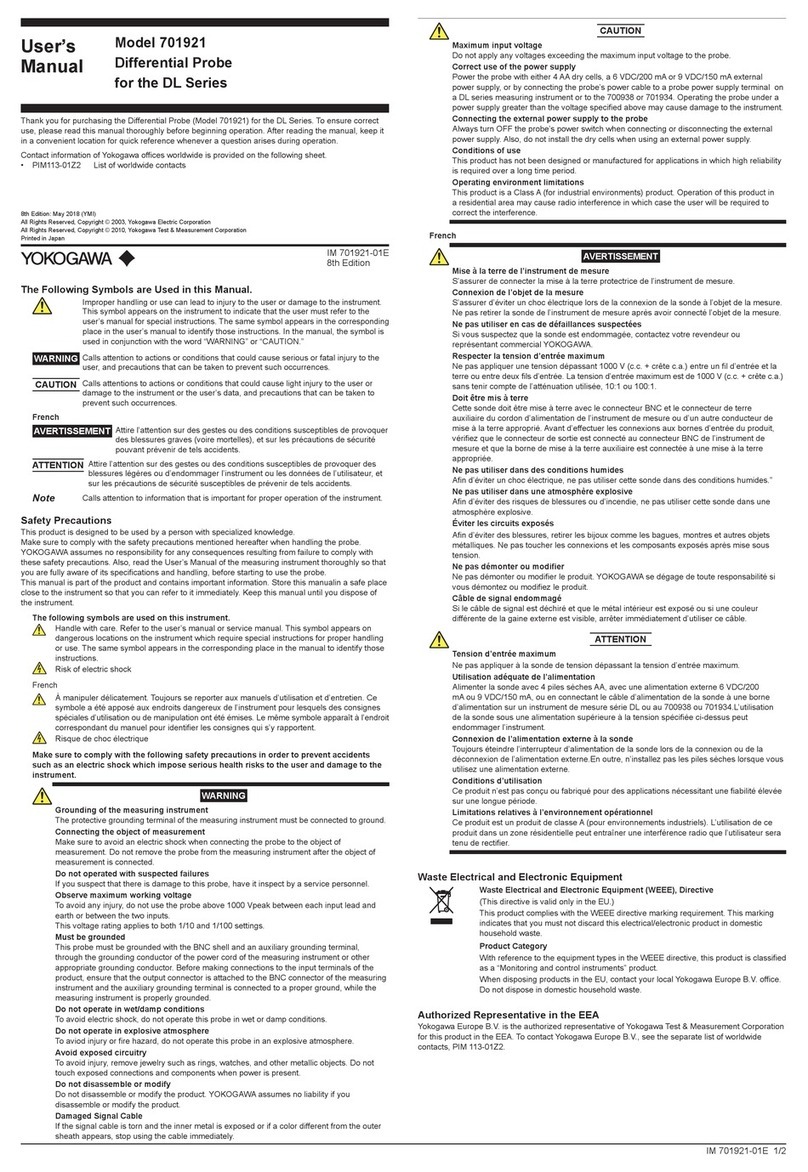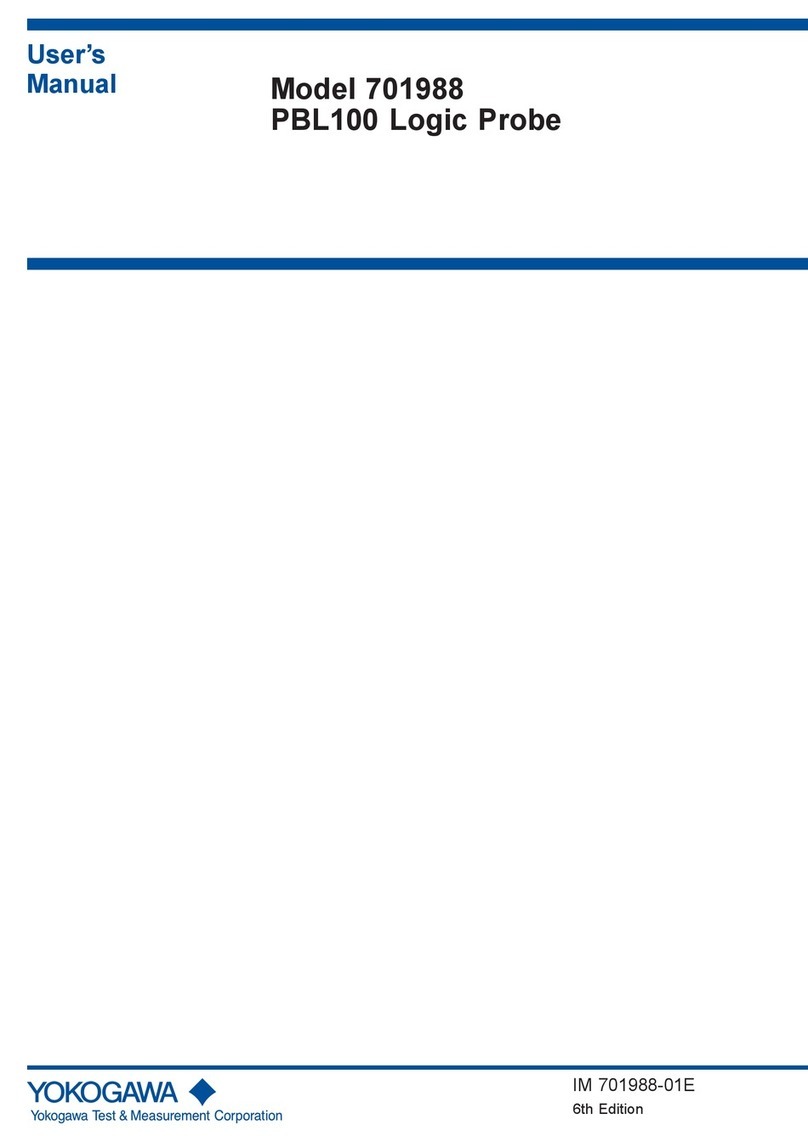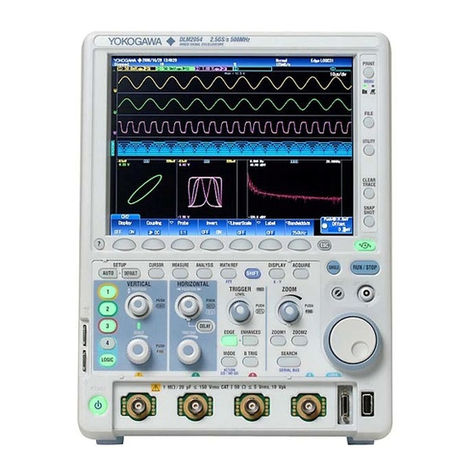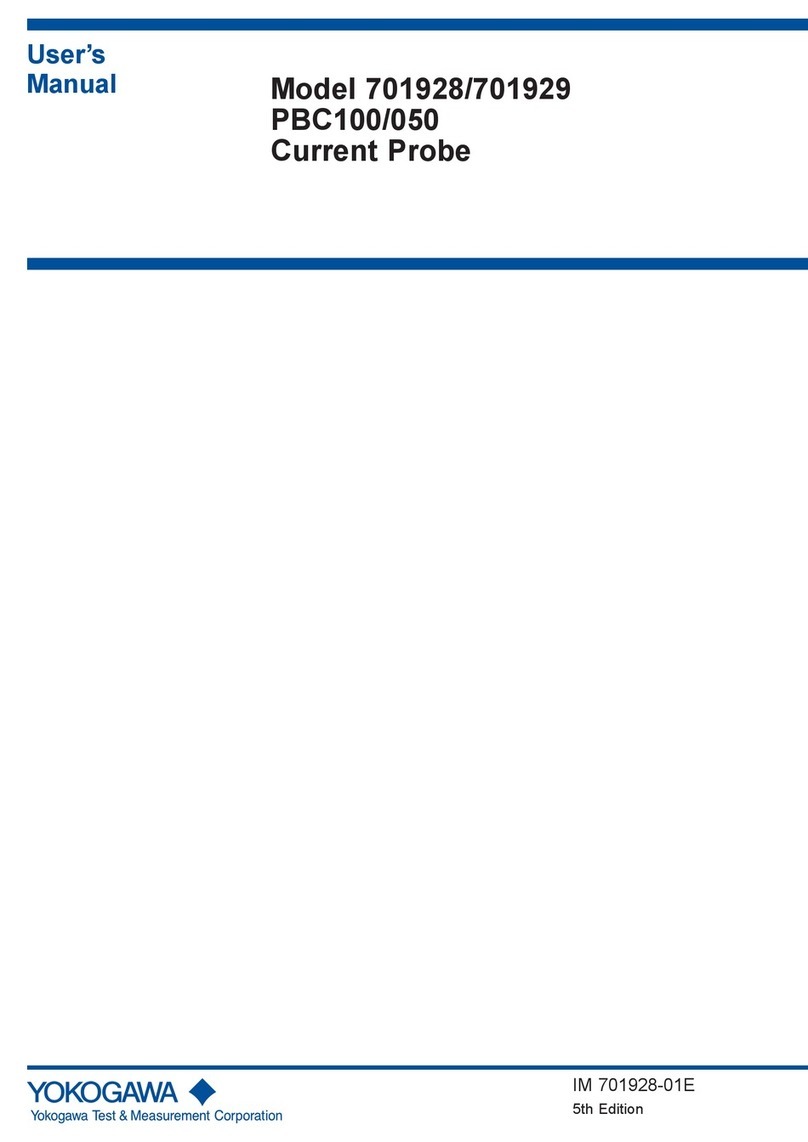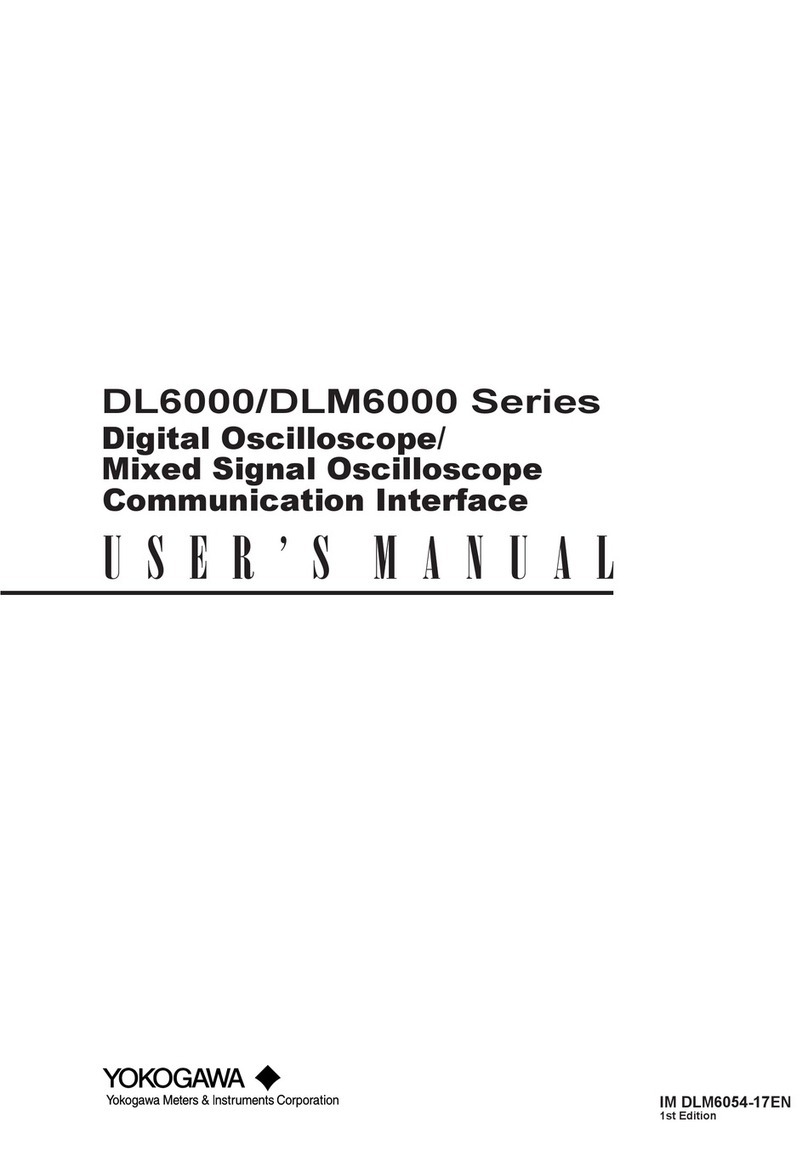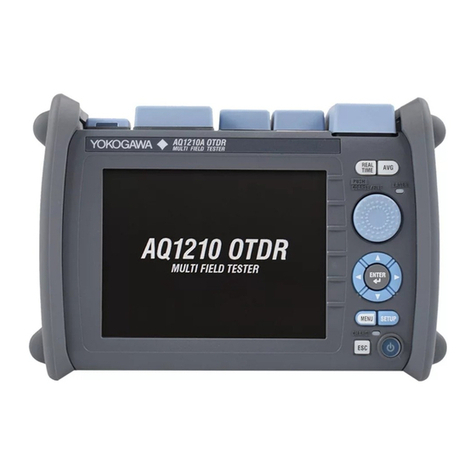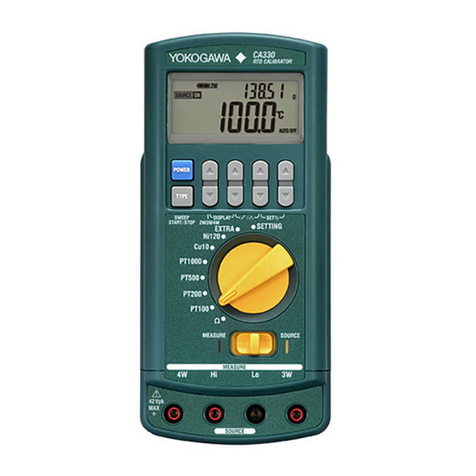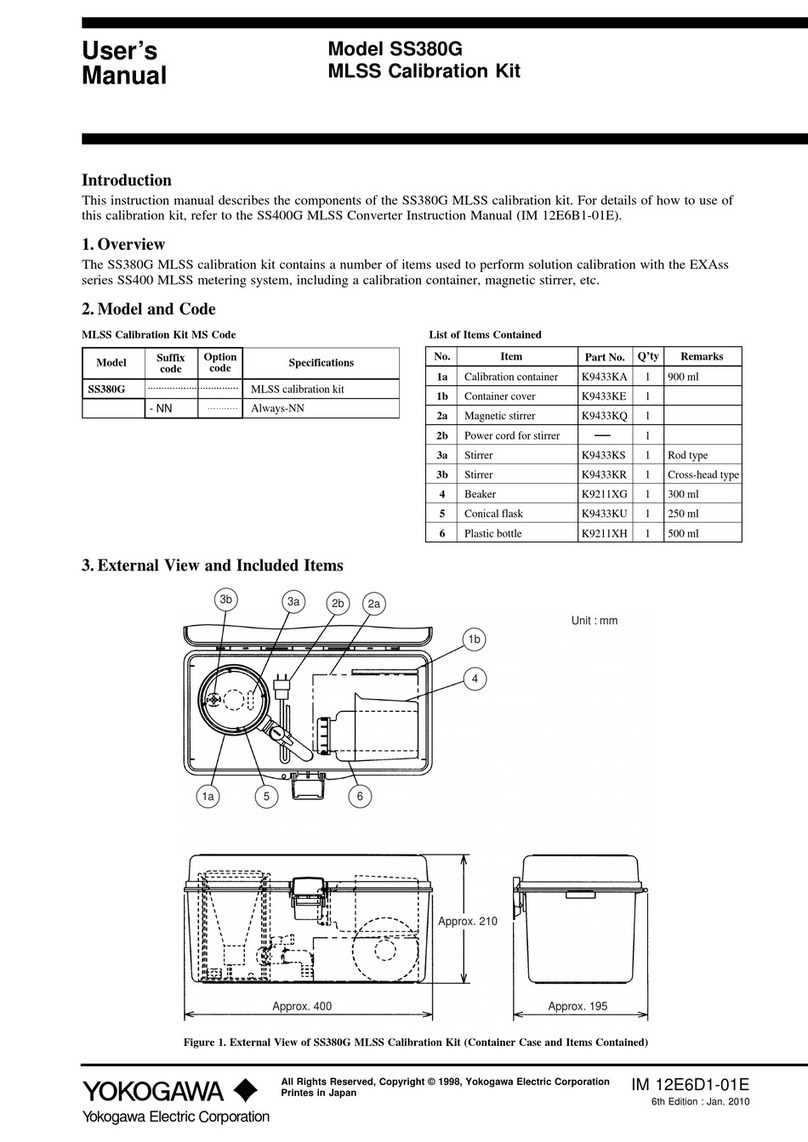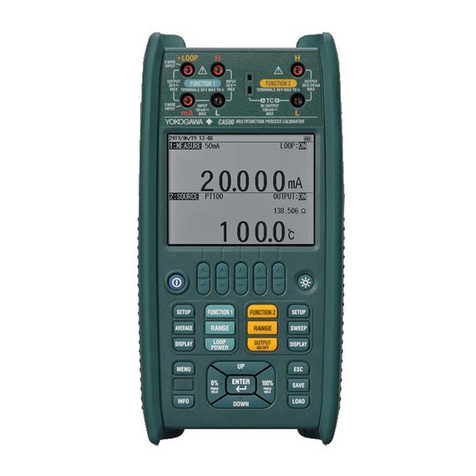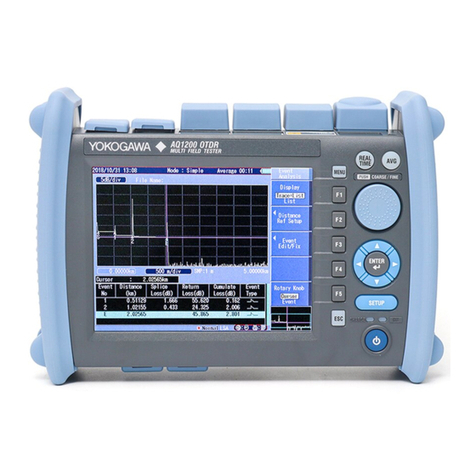
IM CA12E-01E <1>
<6> MEASURE (measurement) / SOURCE (generation) selection switch
Selects MEASURE (measurement) or SOURCE (generation).
<7> Input/output terminals
Used for MEASURE (measurement) and SOURCE (generation) in each range.
<8> 3W input terminal
Used for MEASURE (measurement) in a three-wire connection configuration in the resistance or
RTD range.
<9> Terminal adapter
Attached to the instrument's terminals when measuring a thermocouple signal or when lead wires
are to be connected directly to the terminals.
<10> AC Adapter connection jack
Used to connect an AC adapter (optional).
<11> RJ sensor input connector
When using an external RJ sensor (optional), connect it to this connector.
<12> DIP switches
See Section 7, “Other Features.”
<13> Battery holder
Contains four AA-size batteries. See Section 3, “Replacing Batteries.”
<14> Lead cables for measurement or generation
Used to connect the instrument to the device under measurement/generation.
3. Replacing Batteries
When the
+
-
mark is blinking on the display unit, the batteries are exhausted. Replace them
according to the following procedure:
<1> Check that the power is turned off (disconnect the lead cables).
<2> Slide off the cover at the back of the instrument.
<3> Replace all four batteries with new ones. Insert them according to the polarity directions
shown inside the holder.
<4> After replacing the batteries, return the cover to the original position.
■ Connecting the AC Power (optional)
Before connecting the AC power
Strictly observe the following warnings to avoid electrical shock or damage to the instrument.
WARNING
●Do not use any AC adapter other than the dedicated AC adapter from Yokogawa.
●Before connecting the power cord, check that the supply voltage matches the rated
voltage of the instrument.
●Before connecting the power cord, check that the instrument’s power key is OFF.
Connection procedure:
<1> Check that the [POWER] key of the instrument is off.
<2> Connect the AC adapter (optional) to the instrument’s AC adapter connection jack. (Note that
unless the AC adapter is connected to the power outlet, the power cannot be turned on).
4. Turning the Power On/Off
■ Operating the POWER Key
When the instrument’s power is off, pressing and holding the [POWER] key for more than 1
second causes the power to be turned on. Pressing the key again causes it to be turned off.
When the power is turned on, the instrument starts a self-test and displays “CA12E.” Then the
features selected using the range selection rotary switch and the MEASURE/SOURCE selection
switch start functioning.
• For battery-driven operations, disconnect the AC adapter from the instrument.
■ Automatic Power Off
In the factory setting, all indications start blinking if the instrument has not been operated for about
9.5 minutes. Then, if the instrument is not operated for another 30 seconds, it automatically turns
off. To disable this automatic power off feature, see Section 7, “Other Features.”
If you wish to keep the instrument turned on after the indications start blinking, press the [POWER]
key (or any other key). This causes the blinking to return to normal lighting, without changing the
previous settings.
5. SOURCE (generation)
5.1 Connecting the Output Terminals
<1> Insert the plugs of the supplied lead cables into the output terminals of the instrument.
<2> Connect the clips on the other ends of the cables to the input terminals of the device under
generation.
Lo
3W
Lo Hi
3W
Lo Lo Hi
Lo Hi
3W
(a) Voltage (Thermocouple),
2W Resistance (RTD) OUTPUT (b-1) 3W Resistance (RTD) OUTPUT (b-2) 3W Resistance (RTD) OUTPUT
Lo Lo Hi
Lo
3W
Lo Hi
3W
Lo Lo Hi
<1> Terminal
adapter
<1> Short bar
(supplied)
<2> Terminal
adapter
• When calibrating a resistance temperature detector or a resistance measurement unit in a
three-wire connection configuration, the supplied terminal adapter can be used to achieve a
three-wire connection configuration without shorting the Lo terminal (Fig. b-1). Lo and 3W-Lo
terminals can be shorted (Fig. b-2). Otherwise connect as shown in Fig. a.
1. Safety Precautions
When operating the instrument, strictly observe the precautions below to ensure its correct and safe
operation. If used other than as instructed in this manual, Yokogawa Meters & Instruments Corporation
is not liable for any damage that may result.
■ The following safety symbols are used on the instrument and in the manual:
Danger! Handle with care.
This symbol indicates that the operator must refer to an explanation in the User's Manual in
order to avoid risk of injury or death of personnel or damage to the instrument.
WARNING Indicates a hazard that may result in the loss of life or serious injury of the user unless the
described instruction is abided by.
CAUTION Indicates a hazard that may result in an injury to the user and/or physical damage to the
product or other equipment unless the described instruction is abided by.
NOTE Indicates information that is essential for handling the instrument or, should be noted in order
to familiarize yourself with the instrument’s operating procedures and/or functions.
■Damage to the instrument, personal injury or even death may result from electrical shock or
other factors. To avoid this, follow the precautions below:
WARNING
●Use where gases may be present
Do not operate the instrument in a location where flammable or explosive gas/vapor present. It is
extremely hazardous to operate the instrument in such an atmosphere.
●External connection
If necessary to touch a circuit to make an external connection, turn off the power to that circuit,
ensure there is no voltage, then perform the connection. When replacing the batteries, disconnect the
lead cables in advance.
●Disassembly
Do not disassemble or remodel the instrument yourself. This needs to be done by our service
personnel.
2. Names and Functions of Parts
ON
123 4
<8> Three-wire input
terminal
<3> POWER
key
<4> SHIFT
key
<1> Display unit
<2> Output value
setting keys
<5> Range selection
rotary switch
<10> AC Adapter
connection jack
<7> Voltage/resistance
input and output terminals
<6> MEASURE
(measurement)/
SOURCE
(generation)
selection switch
Side ViewFront View Rear View
(with the rear cover removed)
Red
Black
Black
<12> DIP
switches
<13> Battery
holder
<14> Lead cables
<9> Terminal adapter
<11> RJ sensor
input connector
<1> Display unit
a. MEASURE
Lights up when MEASURE (measurement) is
selected using the selection switch <6>.
b. SOURCE
Lights up when SOURCE (generation) is
selected using the selection switch <6>.
c. CAL
Lights up in the calibration mode.
d. 0/FS
Lights up or blinks when offset or full-scale adjustment is performed in the calibration mode.
e.
+
-
This mark indicates the battery’s status. When lit, it indicates the batteries will soon need
replacing. When blinking, it indicates that they must be replaced (see Section 3, “Replacing
Batteries”).
f. Main Seven Segment
Displays a measured value or an output value.
g. Sub Seven Segment
<PT100 range> When IPTS68 is selected by DIP switch 3, 68 is displayed.
<Thermocouple range> When the U, L, B, or S range is selected using the SHIFT key, the type
of thermocouple is displayed.
<Calibration mode> This mode displays the lower two digits of the measured or generated value.
h. Displays the unit of the range selected.
i. ON
It lights up when the output is turned on in SOURCE mode (signal generation).
j. RJ-ON
It lights up when the reference junction compensation is being calculated in SOURCE mode
(signal generation).
k. JPT100
It lights up when the JPT100 standard is selected in the RTD range (PT100 range). Refer to
Section 5.3 “Generating Resistance or RTD Signal”, 6.3 “Measuring Resistance or RTD Signal”
and 7, “Other Features.”
<2> Output value setting keys
Sets an output value for SOURCE mode (signal generation). The [▲]/[▼] keys are provided under
each digit, whose value is increased or decreased in increments of 1. Carry of the digit is applied
to increasing the value (pressing the [▲] key) when it is 9. Borrow of the digit is applied to decreas-
ing the value (pressing the [▼] key) when it is 0.
<3> POWER key
Turns on/off the power supply. For more information, see Section 4, “Turning the Power On/Off.”
<4> SHIFT key
Selects the type of thermocouple or the resistance temperature detector being selected by the
range selection rotary switch (e.g., thermocouple type: S←→R).
<5> Range selection rotary switch
Selects a range for SOURCE mode (signal generation) or MEASURE mode (measurement).
User’s
Manual CA12E
HANDY CAL
(Temperature Calibrator)
IM CA12E-01E
3rd Edition Sep. 2009 (KP)
Thank you for purchasing the CA12E HANDY CAL. Prior to using, read this User’s Manual carefully to
fully and properly utilize all of the features of this instrument. Also, refer as needed to IM CA12E-02E,
an additional User’s Manual for this instrument.
-1-
MEASURE
SOURCE
ON
+
-
RJ-ON
JPT100
CAL
FS
0
a
b
f c
d
g
ie jk h
■ Notice regarding the Manual
<1> The information contained in this User’s Manual is subject to change without notice.
<2> Every effort has been made to ensure that the information contained herein is accurate.
However, should any concerns, errors, or omissions come to your attention, or if you have any
comments, please contact us.
IM3E-2009.2
Yokogawa Meters & Instruments Corporation
International Sales Dept.
Tachihi Bld. No.2, 6-1-3, Sakaecho, Tachikawa-shi,Tokyo 190-8586 Japan
Phone: 81-42-534-1413, Facsimile: 81-42-534-1426
YOKOGAWA CORPORATION OF AMERICA (U.S.A.)
Phone: 1-800-888-6400 Facsimile: 1-770-254-0928
YOKOGAWA EUROPE B. V. (THE NETHERLANDS)
Euroweg 2, 3825 HD, Amersfoort, THE NETHERLANDS
Phone: 31-88-4641000 Facsimile: 31-88-4641111
YOKOGAWA AMERICA DO SUL LTDA. (BRAZIL)
Phone: 55-11-5681-2400 Facsimile: 55-11-5681-4434
YOKOGAWA ENGINEERING ASIA PTE. LTD. (SINGAPORE)
Phone: 65-6241-9933 Facsimile: 65-6241-2606
YOKOGAWA MEASURING INSTRUMENTS KOREA CORPORATION (KOREA)
Phone: 82-2-551-0660 to -0664 Facsimile: 82-2-551-0665
YOKOGAWA AUSTRALIA PTY. LTD. (AUSTRALIA)
Phone: 61-2-8870-1100 Facsimile: 61-2-8870-1111
YOKOGAWA INDIA LTD. (INDIA)
Phone: 91-80-4158-6000 Facsimile: 91-80-2852-1441
YOKOGAWA SHANGHAI TRADING CO., LTD. (CHINA)
Phone: 86-21-6239-6363 Facsimile: 86-21-6880-4987
YOKOGAWA MIDDLE EAST B. S. C (C) (BAHRAIN)
Phone: 973-17-358100 Facsimile: 973-17-336100
YOKOGAWA ELECTRIC CIS LTD. (RUSSIAN FEDERATION)
Phone: 7-495-737-7868 Facsimile: 7-495-737-7869

